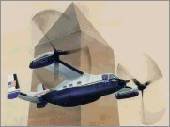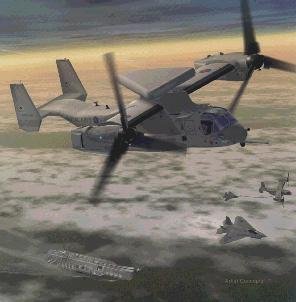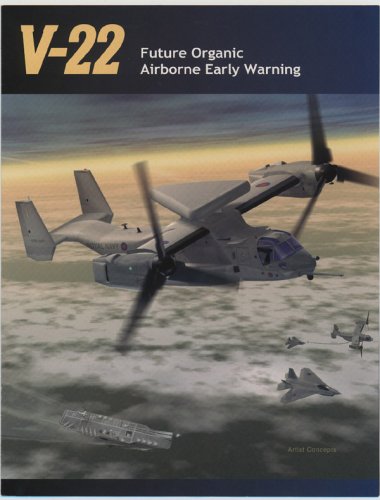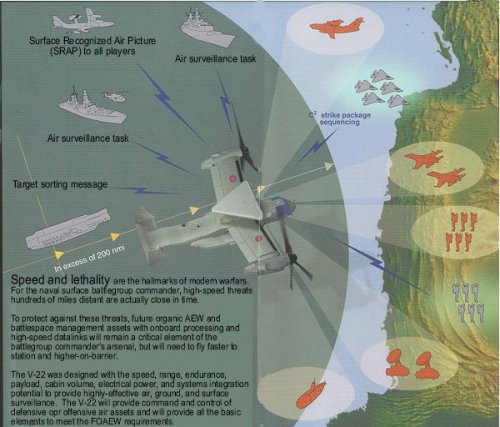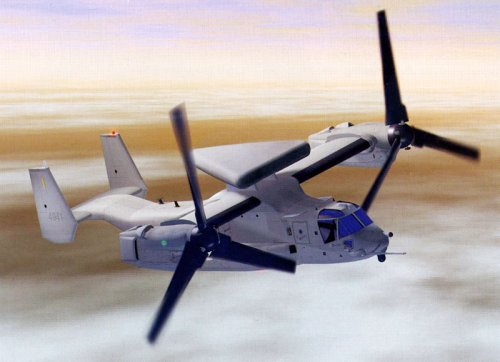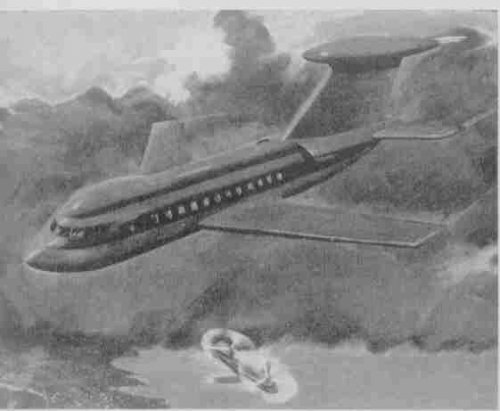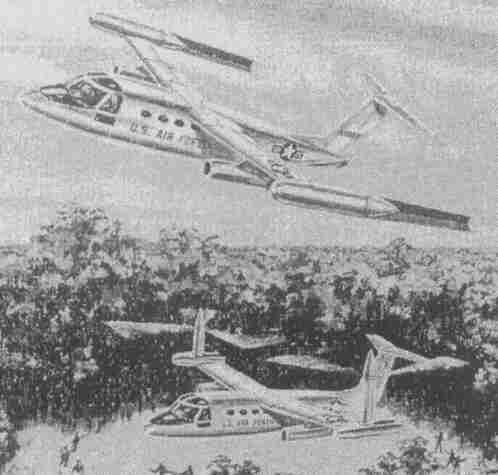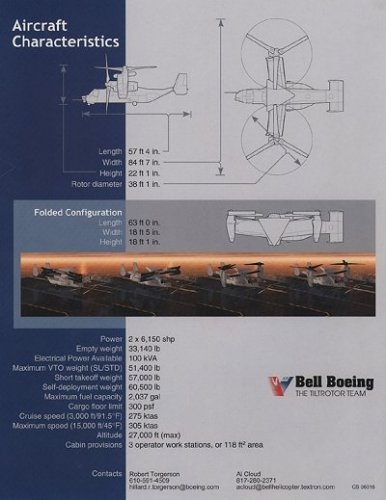yasotay said:
A bump to this thread, as a good place to discuss the origins of the V-22 program... in particular the HXM and its implications for the establishment of the JVX program (whick became the V-22 series).
I've been away for a while, but while I'm back here its the story of HXM and how JVX was born (kinda long):
What would eventually be come JVX actually started out as a Maine Corps program in 1968 called HXM, which apparently stood for Helicopter eXperimental Marines. It was planned to reduce all USMC transports down to one model, and was intended to succeed the CH-46. The final requirements for HXM, which were all the Marines originally wanted form what would become JVX are below. One note on these specs: The USMC is much more concerned with “real world” rather than artificial environments. Whenever almost anyone else states requirements, they do it in terms of sea level, standard day. The USMC states its requirements (including these) in terms of 3,000 ft. 91.5 degree day:
Payload: 18-24 fully equipped troops
Radius with above, 200 nm
External lift: 10,000 lbs.
Endurance: 3 hrs
Cruise speed: 180 knots
Shipboard spotting factor relative to H-46 1.0-1.2
Note that this was beyond what any rotorcraft of the time could do, but was expected to be within the reach of advanced conventional rotorcraft of the future. Note also that Tilt-Rotor was not specified. In fact, at this point in time, the leading candidate was the proposal that later surfaced as the Boeing Model 360. The speed was what was thought to have been achievable from an advanced rotorcraft of an unspecified type, of which there were gangs of proposals.
HXM began in 1968. In 1971 USMC was directed to join Army in their upcoming transport helicopter program, UTTAS, which eventually would become the UH-60. Army chose a conservative route which would not meet USMC needs. In 1972, Navy comes up with Sea Control Ship concept and HXM is joined with Navy HSX (Helicopter Sea eXperimental) to operate form Sea Control Ship. Sea Control Ship sinks of its own weight and HSX goes away. Navy then plans two V/STOL aircraft, V/STOLs A & B, the former being a subsonic support aircraft, the latter a supersonic fighter. HXM becomes part of V/STOL A. V/STOLS A&B then crashed and burned; HXM reemerges. During this decade Congress under prodding from unnamed lobbyists, directs USMC multiple times to study using UH-60 for Marines’ mission. All studies, done by USMC and independent organizations show that this won't work. Unless you redefine the mission down to what the UH-60 can perform rather than what the Marines need, so Congress in 1979 gives permission for USMC to finally proceed with HXM, with FY 1982 set for HXM competition.
In December 1981, the new Administration took a look at the HXM program and decided funding an unique vehicle jut for the Marines wasn’t justified, and directed that it be combined into a joint program for the AF, Army, Navy and Marines with a common aerodynamic vehicle with custom equipment as needed for each services particular needs. The USMC vehicle requirement would be the baseline. This became JVX, which was more capable, flexible (and expensive) than the Marines HXM. The original planned program was:
USMC: 552 a/c replacing CH-46 & CH-53A/D
USA: 200 a/c configured for the SEMA (Special Electronics Mission Aircraft) role and 24 “regular” JVXs for MEDEVAC.
USAF: 200 configured for SOF and CSAR replacing HH-3, HH-53 and HH-60 (1980s designations).
USN: 50 configured for CSAR and logistics, replacing CH-46.
Although USMC had a requirement for more a/c than all other users combined, Army was put in charge of JVX for a couple of reasons. First, the Army had more experience in running a new-design a/c program from scratch. Second, up to this point the Army had been a strong champion of advanced rotorcraft in general and Tilt-Rotor in particular (by this point people were starting to realize what they could get with Tilt-Rotor). AVRADCOM was a big player in the advanced rotorcraft field and probably had the most expertise of any Government agency
In fact, it was the Army that had saved Tilt-Rotor. NASA had originally been developing the XV-15, the technology demonstrator of the technology. NASA leadership, in those days, thought practical development of technologies was somehow “beneath” them, they were a pure research organization, and actually developing something to the point of practical operation was something they didn’t really want to deal with. So, after the XV-15 proved itself the most (some wags said “only”) successful aerodynamic program in its history, NASA was simply going to put the whole thing on the shelf and go on to other things. The Army came in at this point with money to help fund a joint program with NASA to further refine the concept on one of the XV-15s. The other XV-15 was to be sent to a museum when Bell came in and leased it back from NASA and did its own development work as well as flying it around the country showing what they had achieved.
However, the Army was now starting to show some reluctance. Although only scheduled to get 26% of the JVXs, the program structure planned for ti to foot 46% of R&D. So, funding was changed to 50% Navy/USMC, 34% Army and 16% Air Force.
NASA and Army planned a simulated “fly-off” between various competitors concepts. A major assumption had to be made, though. This assumption was that the competitors’ concepts would actually work. With the exception of Tilt-Rotor, all other unconventional rotorcraft concepts had a best failed to deliver or at worst had been outright flops. Still, for the purpose of this "flyoff", it was assumed that the technologies would perform as advertised. The results showed that while some technologies could perform various aspects of the JVX mission better than others, only Tilt-Rotor could perform all of them.
Bell, meanwhile had upgraded its HXM proposal (they always wanted to go with Tilt-Rotor) into the Model 327. At this point the US Government started to heavily push for “teaming” arrangements between various aircraft manufacturers. Well, the two companies with the most Tilt-Rotor experience were Bell and Boeing. They made the logical decision to team. They then produced their joint proposal, the model 901-X. The only problem with this was that now the only two competitors that had a technology capable of meeting the requirements were no longer competitors and were submitting a joint bid. Since no one else had a technology capable of meeting the need, and the Government wasn’t willing to abandon mission requirements just so that someone else could bid, the other competitors simply didn’t bid.
Sometime after this, the Army pulled out. There were probably a number of reasons. One was that USAF didn’t like the performance of the Army SEMA version (being too close to what they thought was “their” mission) and lobbied against it, and that version was eventually killed. Secondly, without the SEMA mission, the rest of the Army JVX needs could be filed by “vanilla” JVXs. Since that version was going to be developed no matter what, why not just save the R&D money, let the Navy fund that portion, and buy the USMC version? Finally, JVX was looked at by the Army as a way to fund their Modern Technology Engine (MTE). It was thought by the army that his engine could also be used on their CH-47s and a growth version could be used on the next heavy lift helicopter. In addition it was thought this could be used to power the P-7, and re-engine C130s, E-2s and the like.
The two MTE candidates for the JVX were the GE27 and the Pratt & Whitney PW3005. In addition, a derivative of the Allison T56 was in the running for JVX, although it wasn’t an MTE. On December 20, 1985 the Commander of NAVAIR briefed the Secretary of the Navy on which engine was to be selected for JVX. Rumor has it that it was the GE MTE. After SECNAV received the recommendation, the selecting official was replaced and SECNAV made himself the selecting official. At 4 PM on Christmas Eve, it was quietly announced that the T56 derivative (then designated 501-M80C but today known as the T406) would power JVX. This decision had profound effects on the JVX’s capabilities which are outside the scope of this post. In any case, at this point the Army didn’t see much in the program for it, so it pulled out, choosing instead to use the money on the poorly conceived LHX program which predictably came to naught.


